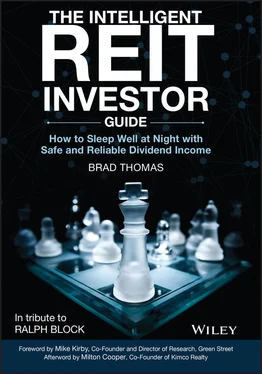The primary appeal is obvious: Publicly traded REITs turn an asset class that is otherwise illiquid and hard to access into something that can be bought or sold with a few clicks on a keypad. In addition, today's REITs are best‐in‐class companies that own some of the highest‐quality real estate. In most U.S. property sectors, REITs dominate the list of largest property owners, and they bring a level of managerial acumen and operational expertise that is often not found among smaller players. Their size also affords efficiency on overhead and borrowing costs, and their corporate governance practices provide reasonable alignment of interests between managers and investors.
As a result, the REIT model has thrived. In the United States, REITs now own more than $1.5 trillion of real estate. In addition to traditional property sectors such as retail, office, industrial, and apartments, REITs are dominant owners of cell towers, data centers, healthcare facilities, single‐family rentals, and numerous niche sectors. This exposure to non‐traditional property types poised to prosper in tomorrow's economy is impossible to replicate via other investment vehicles. Outside of the United States, the REIT template has now been adopted in 40 countries, and there are nearly 500 REITs scattered across the globe. Further expansion both domestically and globally is a certainty.
This growth has been accompanied by excellent returns. The industry reached adulthood about 25 years ago, and listed property‐owning REITs have delivered total returns that are slightly better than those of either small‐ or large‐cap stocks over that time frame. They have also delivered better risk‐adjusted returns than private‐market real estate investment vehicles. As important, REIT share prices often stray from the market herd, a trait that can soften the blow of broad market downturns. Their demonstrated propensity to enhance returns while reducing risk makes them a valuable addition to any broadly diversified portfolio. These attributes have been quantified and validated by reputable academics and investment consultants employing state‐of‐the‐art portfolio allocation models, with most recommending a weighting of at least 10%.
Common sense also supports an allocation at least that large. Investors should have a roughly proportionate exposure to every asset class, and real estate is a very large asset class. Estimates of the size of this country's commercial property market run a wide gamut, but a credible midpoint that includes a broad array of property types is $17 trillion. That compares with capitalization for the U.S. stock market of $50 trillion, $11 trillion for corporate bonds, and $4 trillion for municipal bonds. Debt obligations backed by the U.S. Treasury tally $30 trillion, but with the Federal Reserve increasingly dictating prices in that market, it's fair to question whether a proportionate allocation is optimal for most investors. There is no “right” allocation for real estate, but portfolios lacking an explicit target of at least 10% are not as well diversified as they should be.
Investing in property, whether via private vehicles or publicly traded REITs, can seem daunting, as the arena is littered with jargon and valuation approaches that are often foreign even to trained investment professionals. Indeed, until the early 1990s, this issue served as an impediment to the acceptance of REITs into the mainstream. At about that time, however, a critical mass of sophisticated investors, analysts, and executives descended on the space, and they invented and popularized the specialized performance and valuation metrics that are ubiquitous today. Their contributions served as foundational building blocks for the subsequent growth and prosperity the industry has enjoyed.
Ralph Block, the author of Investing in REITs , was one of those pioneers. There weren't very many of us back then who took it as self‐evident that publicly traded real estate was a transformative idea, but the vision had no more passionate adherent than Ralph. His enthusiasm for REITs (his email was REITnut@aol.com) was contagious, and his regular newsletters were both informative and fun to read. A quote from Samuel Johnson appeared above each edition: “No one but a blockhead ever wrote, except for money.” As the newsletter was free, the quote was a clever, self‐deprecating joke. And no one ever gleaned more investment insight from a golden retriever than Ralph, but his interviews with his beloved Sammy were classic. The newsletter, certainly a seed for this book, was perhaps a way for Ralph to give back to an investment sector that had given him so much in both financial and intellectual rewards.
Like its legendary namesake, The Intelligent Investor by Ben Graham, the book is full of common‐sense approaches to uncovering value. At the same time, it provides a comprehensive overview of the quantitative metrics necessary to make well‐informed investment decisions. Why does the REIT industry use funds from operations (FFO) and adjusted funds from operations (AFFO) in lieu of earnings per share? Why is “cap ex” so important? Why look beyond dividend yields? What is NAV? How is it calculated, and why does it matter? These and many other questions are adroitly handled.
The Intelligent REIT Investor Guide is a must‐read, not only for investors in REITs, but for anyone hoping to gain perspective and understanding of the commercial real estate industry at large.
Mike Kirby – Co‐founder and Director of Research, Green Street
About Green Street:
Green Street is the preeminent provider of actionable commercial real estate research, news, data, analytics, and advisory services in the U.S. and Europe. For more than 35 years, Green Street has delivered unparalleled intelligence and trusted data on the public and private real estate markets. Green Street is widely recognized as the unbiased authority on REITs, offering a time‐tested approach to valuation with a strong track record for identifying the most attractively priced REITs and property sectors. The firm helps clients gain a thorough understanding of the entire REIT ecosystem at the macro, sector, REIT and property level to drive more informed investments. Learn more at www.greenstreet.com.
CHAPTER 1 REITs: What They Are and How They Work
“The true investor … will do better if he forgets about the stock market and pays attention to his dividend returns and to the operation results of his companies.”
—Benjamin Graham
What's your idea of a perfect investment?
That's a trick question, for the record, since there is no such thing. Greater returns come with greater risk, while lesser risk comes with lower returns. You're just not going to find a stock that offers intense gains and intense safety at the same time.
Even so, those looking for above‐average current returns, reasonably strong long‐term price appreciation, and only modest risk should definitely consider commercial real estate that can generate reliable streams of rental income.
In the past, real estate investing was only available to wealthy entrepreneurs with deep pockets and the ability to acquire and actively manage portfolios of properties. Real estate investment trusts, or REITs (pronounced “reets”), were born out of that environment with the intent to allow small investors the same kinds of benefits.
Congress officially recognized REITs in 1960, patterning them after mutual fund laws. In the beginning, they were severely restricted, mostly meant to just provide investors with a non‐taxed, passive flow‐through form of income. The REIT vehicle received a dividend‐paid deduction from corporate tax for every dollar distributed. And income was taxed only at the shareholder level instead of being double‐taxed like most corporations.
Читать дальше












